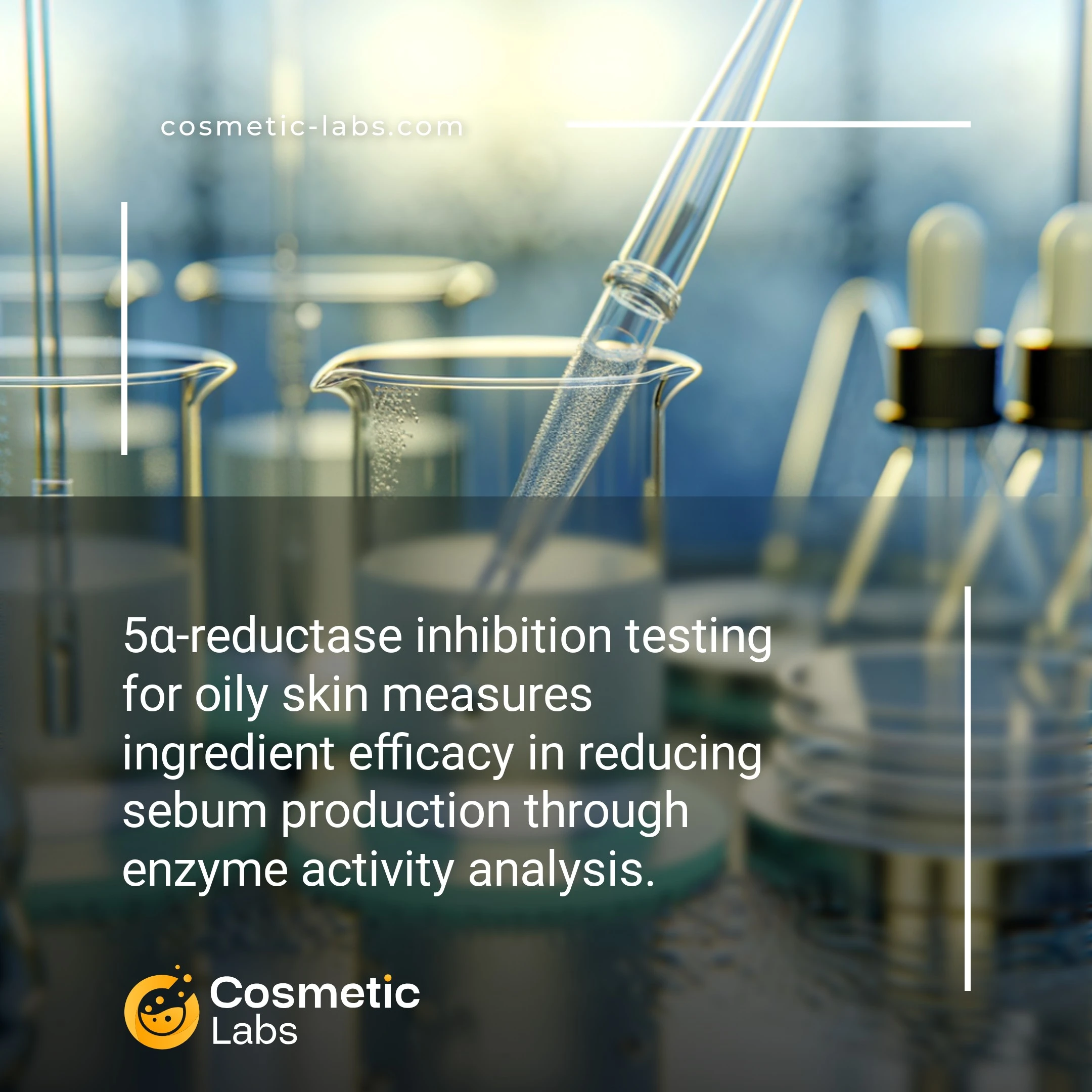5α-Reductase Inhibition Testing for Oily Skin Formulations

What is 5α-reductase inhibition?
5α-reductase inhibition testing for oily skin measures how effectively cosmetic ingredients block the enzyme that converts testosterone to DHT, the hormone responsible for excess sebum production. Our partner labs use in vitro enzyme assays and sebocyte cell cultures to quantify inhibition rates, typically showing 20-80% reduction in sebaceous gland activity. This testing proves your anti-acne formulations work at the hormonal level, not just surface treatments.
Why do you need this service?
Cosmetic labs use 5α-reductase inhibition testing to validate sebum-control formulations before market launch, measuring how botanical extracts like saw palmetto or zinc compounds reduce oil production in controlled skin models. Brands typically request these assays when developing mattifying serums or acne treatments, with testing protocols that quantify sebaceous gland activity reduction within 14-28 day study periods to support product claims.
Who provides 5α-reductase inhibition services?
All cosmetic labs providing 5α-reductase inhibition services
There is no company providing these services at the moment.
5α-Reductase Inhibition Testing for Oily Skin Formulations
Labs measure how effectively your formulations block 5α-reductase enzyme activity to reduce sebum production and control oily skin conditions. This testing validates claims about pore-refining ingredients and oil-control actives before market launch.
Enzyme Activity Assays
Testing facilities use in vitro enzyme inhibition assays to quantify how your ingredients suppress 5α-reductase types I and II. Labs typically run dose-response curves with concentrations from 0.1% to 5% to establish minimum effective levels.
Standard protocols include:
- Spectrophotometric analysis measuring NADPH consumption
- LC-MS detection of dihydrotestosterone formation
- Positive controls using finasteride or dutasteride
- IC50 calculations for potency comparisons
Sebocyte Culture Models
Labs test your formulations on human sebaceous gland cells to measure real-world sebum reduction effects. These cell culture assays show how ingredients perform in biological systems rather than isolated enzyme reactions.
Testing parameters include:
- Lipid production quantification after 48-72 hour exposure
- Cell viability assessments to confirm safety
- Sebum composition analysis via gas chromatography
- Comparative studies against reference compounds
Connect with specialized labs on our platform to validate your oil-control claims through proven 5α-reductase inhibition testing protocols.
Applications of 5α-Reductase Inhibition Testing for Oily Skin Products
Cosmetic labs use 5α-reductase inhibition testing for oily skin to validate sebum control claims and optimize formulations targeting excess oil production.
Anti-Acne Product Development
Labs evaluate botanical extracts and synthetic compounds for their ability to block 5α-reductase enzyme activity, which converts testosterone to dihydrotestosterone (DHT). This testing helps brands develop serums and treatments that reduce sebaceous gland activity. Enzyme inhibition assays measure IC50 values, typically ranging from 10-500 μg/mL for effective ingredients.
Testing protocols include both cell-free enzyme assays and sebocyte culture models. Labs can screen multiple concentrations within 2-3 weeks, providing dose-response curves for formulation optimization.
Sebum Control Ingredient Screening
Cosmetic labs screen raw materials and plant extracts for 5α-reductase inhibition potential before full formulation development. This approach saves time and resources by identifying promising candidates early in the development process. Labs test individual compounds at concentrations from 0.1% to 5% to establish working ranges.
The screening process involves fluorometric assays that detect NADPH consumption, providing quantitative data on enzyme inhibition. Results guide ingredient selection and concentration limits for stable, effective formulations.
| Testing Method | Sample Volume | Timeline | Data Output |
|---|---|---|---|
| Cell-free enzyme assay | 50-100 μL | 3-5 days | IC50 values, % inhibition |
| Sebocyte culture model | 1-2 mL | 7-14 days | Lipid production rates |
| High-throughput screening | 10-25 μL | 1-2 days | Relative activity scores |
Connect with specialized cosmetic labs on our platform to access 5α-reductase inhibition testing services for your oily skin product development needs.
